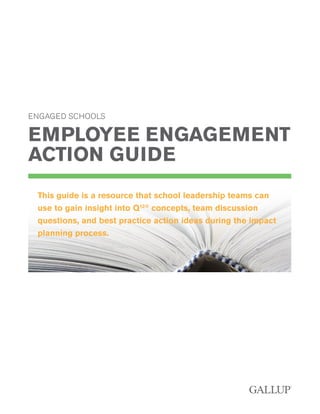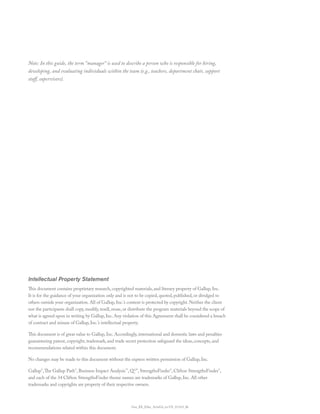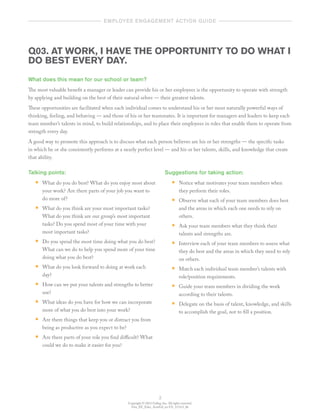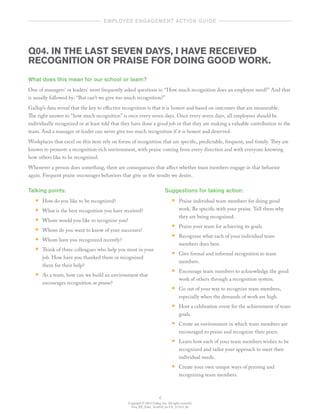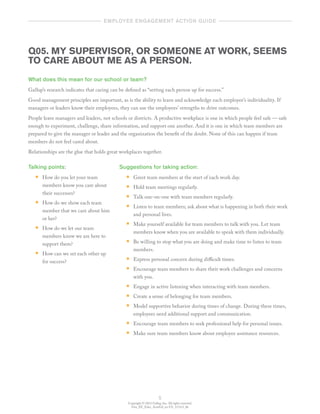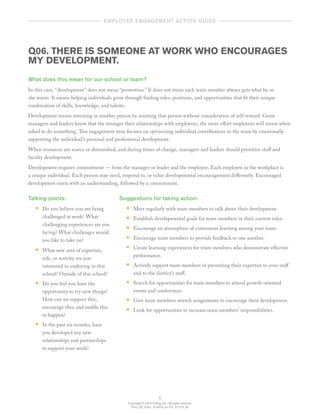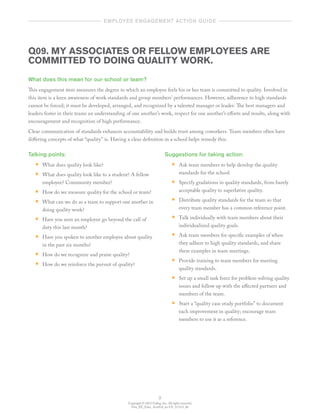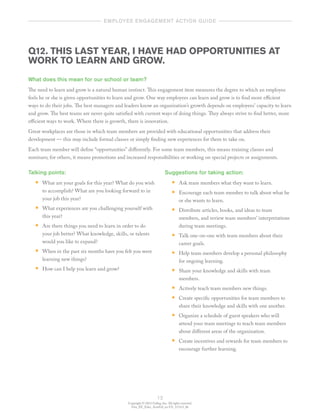12 Engagement Action Plan
- 1. ENGAGED SCHOOLS EMPLOYEE ENGAGEMENT ACTION GUIDE This guide is a resource that school leadership teams can use to gain insight into Q12® concepts, team discussion questions, and best practice action ideas during the impact planning process.
- 2. Note: In this guide, the term “manager” is used to describe a person who is responsible for hiring, developing, and evaluating individuals within the team (e.g., teachers, department chair, support staff, supervisors). Intellectual Property Statement This document contains proprietary research, copyrighted materials, and literary property of Gallup, Inc. It is for the guidance of your organization only and is not to be copied, quoted, published, or divulged to others outside your organization. All of Gallup, Inc.’s content is protected by copyright. Neither the client nor the participants shall copy, modify, resell, reuse, or distribute the program materials beyond the scope of what is agreed upon in writing by Gallup, Inc. Any violation of this Agreement shall be considered a breach of contract and misuse of Gallup, Inc.’s intellectual property. This document is of great value to Gallup, Inc. Accordingly, international and domestic laws and penalties guaranteeing patent, copyright, trademark, and trade secret protection safeguard the ideas, concepts, and recommendations related within this document. No changes may be made to this document without the express written permission of Gallup, Inc. Gallup® ,The Gallup Path® , Business Impact Analysis™ , Q12® , StrengthsFinder® , Clifton StrengthsFinder® , and each of the 34 Clifton StrengthsFinder theme names are trademarks of Gallup, Inc. All other trademarks and copyrights are property of their respective owners. Gen_EE_Educ_ActnGd_en-US_1112v3_bk
- 3. Copyright © 2012 Gallup, Inc. All rights reserved. Gen_EE_Educ_ActnGd_en-US_1112v3_bk 1 employee engagement action guide Q01. I KNOW WHAT IS EXPECTED OF ME AT WORK. What does this mean for our school or team? Clarity of expectations — perhaps the most basic of employee needs in the workplace — is critical to performance. Yet, approximately half of American workers are unclear about what they are supposed to do at work. Gallup’s research indicates that this element of employee engagement predicts future patterns of turnover, student and community engagement, safety incidents, and productivity. Outstanding performance is borne of clearly defined expectations. Gallup’s research also shows that many great workplaces have defined the right outcomes; they set goals for their team members or work with them to set their own goals. They do not just define the job, but define success on the job. For team members to be aware of what is expected of them, they should have a way to rank, rate, or count as many of the desired outcomes as possible. These measures of performance should fit with what the rest of the organization is saying and doing. Talking points: •• What do you get paid to do? •• How can we be clear in terms of our expectations of each other? What are the best ways to communicate what is expected? •• What does the organization expect of us? What are our essential responsibilities? Do you know what the superintendent or the school board expects of us? Do you know what their priorities are? •• Do our expectations of each other change when we are busy? •• Do others have any “wrong” expectations of you? How do you want to address those expectations? •• Do you ever feel conflicted about priorities? How can we as a team help each other communicate needs and priorities during these times? •• Do you know the direction in which the school is moving? How does this help you understand what is expected of you? •• What are the standards for a great performance in your role/position? What are your points of comparison? Suggestions for taking action: •• Ensure that each staff and faculty member understands his or her role and responsibilities. •• Ensure that individual performance reviews address the following three questions: -- Where are we going (our team’s vision or outcomes)? -- What do we believe in (our team’s guiding values or principles)? -- Why do we exist (our reason for being, mission, or purpose)? •• Explain standard operating procedures, as well as new programs to ensure consistent execution. •• Hold a one-on-one meeting with each team member to set performance expectations. •• Meet as a team to collaborate, design, and set performance goals. •• Hold a grade-level or subject-area team meeting to clarify expectations. •• Involve team members in setting their own individual performance goals. •• Help your employees develop 1-, 3-, 5-, and 10-year goals.
- 4. Copyright © 2012 Gallup, Inc. All rights reserved. Gen_EE_Educ_ActnGd_en-US_1112v3_bk 2 employee engagement action guide Q02. I HAVE THE MATERIALS AND EQUIPMENT I NEED TO DO MY WORK RIGHT. What does this mean for our school or team? When managers or leaders ask employees to accomplish a goal but do not provide them with the necessary resources, credibility is lost. Great managers and leaders discover the needs of each person in relation to the outcomes they are attempting to achieve and position resources accordingly. One of the strongest predictors of engagement, this item also predicts employee retention, safety, and productivity. According to Gallup’s extensive research, great managers and leaders find out what people need in the way of materials and equipment. Great managers and leaders also communicate how team members can earn the right to certain materials and equipment. A great way for team members to increase their responsiveness to this item is to determine what “materials and equipment” means to them. Sometimes they are referring to accessibility of information, rather than equipment or supplies. Talking points: •• When you think of materials and equipment, what comes to mind? •• What are the essentials? What materials and equipment are essential to doing your job well? How happy are you with the availability and functionality of each of these essentials? •• Are there things that distract you from being positive, productive, or accurate in the work you do? •• Does your work equipment lead to any stress? How can we help alleviate this stress? •• Do we have enough people to get the job done right? How can we work together when our resources are limited? •• Do you have the training you need? Suggestions for taking action: •• Ask team members what tools and equipment they need to do their jobs right. •• Explain what can be done — and when — to provide the tools and equipment that team members need to do their jobs efficiently and effectively. •• Ask team members what information they need to do their jobs right. •• Explain what information is available now, or will be available in the future, that could help team members do their work efficiently and effectively to prevent work disruptions. •• Create an open dialogue with team members that encourages them to talk about what they need to perform their jobs effectively. •• Promptly follow up with team members about their requests for tools, equipment, and information. •• Help your team members think about the prioritization of limited resources. •• Help your team members think about alternatives when resources are limited.
- 5. Copyright © 2012 Gallup, Inc. All rights reserved. Gen_EE_Educ_ActnGd_en-US_1112v3_bk 3 employee engagement action guide Q03. AT WORK, I HAVE THE OPPORTUNITY TO DO WHAT I DO BEST EVERY DAY. What does this mean for our school or team? The most valuable benefit a manager or leader can provide his or her employees is the opportunity to operate with strength by applying and building on the best of their natural selves — their greatest talents. These opportunities are facilitated when each individual comes to understand his or her most naturally powerful ways of thinking, feeling, and behaving — and those of his or her teammates. It is important for managers and leaders to keep each team member’s talents in mind, to build relationships, and to place their employees in roles that enable them to operate from strength every day. A good way to promote this approach is to discuss what each person believes are his or her strengths — the specific tasks in which he or she consistently performs at a nearly perfect level — and his or her talents, skills, and knowledge that create that ability. Talking points: •• What do you do best? What do you enjoy most about your work? Are there parts of your job you want to do more of? •• What do you think are your most important tasks? What do you think are our group’s most important tasks? Do you spend most of your time with your most important tasks? •• Do you spend the most time doing what you do best? What can we do to help you spend more of your time doing what you do best? •• What do you look forward to doing at work each day? •• How can we put your talents and strengths to better use? •• What ideas do you have for how we can incorporate more of what you do best into your work? •• Are there things that keep you or distract you from being as productive as you expect to be? •• Are there parts of your role you find difficult? What could we do to make it easier for you? Suggestions for taking action: •• Notice what motivates your team members when they perform their roles. •• Observe what each of your team members does best and the areas in which each one needs to rely on others. •• Ask your team members what they think their talents and strengths are. •• Interview each of your team members to assess what they do best and the areas in which they need to rely on others. •• Match each individual team member’s talents with role/position requirements. •• Guide your team members in dividing the work according to their talents. •• Delegate on the basis of talent, knowledge, and skills to accomplish the goal, not to fill a position.
- 6. Copyright © 2012 Gallup, Inc. All rights reserved. Gen_EE_Educ_ActnGd_en-US_1112v3_bk 4 employee engagement action guide Q04. IN THE LAST SEVEN DAYS, I HAVE RECEIVED RECOGNITION OR PRAISE FOR DOING GOOD WORK. What does this mean for our school or team? One of managers’ or leaders’ most frequently asked questions is: “How much recognition does an employee need?” And that is usually followed by: “But can’t we give too much recognition?” Gallup’s data reveal that the key to effective recognition is that it is honest and based on outcomes that are measurable. The right answer to “how much recognition” is once every seven days. Once every seven days, all employees should be individually recognized or at least told that they have done a good job or that they are making a valuable contribution to the team. And a manager or leader can never give too much recognition if it is honest and deserved. Workplaces that excel on this item rely on forms of recognition that are specific, predictable, frequent, and timely. They are known to promote a recognition-rich environment, with praise coming from every direction and with everyone knowing how others like to be recognized. Whenever a person does something, there are consequences that affect whether team members engage in that behavior again. Frequent praise encourages behaviors that give us the results we desire. Talking points: •• How do you like to be recognized? •• What is the best recognition you have received? •• Whom would you like to recognize you? •• Whom do you want to know of your successes? •• Whom have you recognized recently? •• Think of three colleagues who help you most in your job. How have you thanked them or recognized them for their help? •• As a team, how can we build an environment that encourages recognition or praise? Suggestions for taking action: •• Praise individual team members for doing good work. Be specific with your praise. Tell them why they are being recognized. •• Praise your team for achieving its goals. •• Recognize what each of your individual team members does best. •• Give formal and informal recognition to team members. •• Encourage team members to acknowledge the good work of others through a recognition system. •• Go out of your way to recognize team members, especially when the demands of work are high. •• Host a celebration event for the achievement of team goals. •• Create an environment in which team members are encouraged to praise and recognize their peers. •• Learn how each of your team members wishes to be recognized and tailor your approach to meet their individual needs. •• Create your own unique ways of praising and recognizing team members.
- 7. Copyright © 2012 Gallup, Inc. All rights reserved. Gen_EE_Educ_ActnGd_en-US_1112v3_bk 5 employee engagement action guide Q05. MY SUPERVISOR, OR SOMEONE AT WORK, SEEMS TO CARE ABOUT ME AS A PERSON. What does this mean for our school or team? Gallup’s research indicates that caring can be defined as “setting each person up for success.” Good management principles are important, as is the ability to learn and acknowledge each employee’s individuality. If managers or leaders know their employees, they can use the employees’ strengths to drive outcomes. People leave managers and leaders, not schools or districts. A productive workplace is one in which people feel safe — safe enough to experiment, challenge, share information, and support one another. And it is one in which team members are prepared to give the manager or leader and the organization the benefit of the doubt. None of this can happen if team members do not feel cared about. Relationships are the glue that holds great workplaces together. Talking points: •• How do you let your team members know you care about their successes? •• How do we show each team member that we care about him or her? •• How do we let our team members know we are here to support them? •• How can we set each other up for success? Suggestions for taking action: •• Greet team members at the start of each work day. •• Hold team meetings regularly. •• Talk one-on-one with team members regularly. •• Listen to team members; ask about what is happening in both their work and personal lives. •• Make yourself available for team members to talk with you. Let team members know when you are available to speak with them individually. •• Be willing to stop what you are doing and make time to listen to team members. •• Express personal concern during difficult times. •• Encourage team members to share their work challenges and concerns with you. •• Engage in active listening when interacting with team members. •• Create a sense of belonging for team members. •• Model supportive behavior during times of change. During these times, employees need additional support and communication. •• Encourage team members to seek professional help for personal issues. •• Make sure team members know about employee assistance resources.
- 8. Copyright © 2012 Gallup, Inc. All rights reserved. Gen_EE_Educ_ActnGd_en-US_1112v3_bk 6 employee engagement action guide Q06. THERE IS SOMEONE AT WORK WHO ENCOURAGES MY DEVELOPMENT. What does this mean for our school or team? In this case, “development” does not mean “promotion.” It does not mean each team member always gets what he or she wants. It means helping individuals grow through finding roles, positions, and opportunities that fit their unique combination of skills, knowledge, and talents. Development means investing in another person by assisting that person without consideration of self-reward. Great managers and leaders know that the stronger their relationships with employees, the more effort employees will invest when asked to do something. This engagement item focuses on optimizing individual contributions to the team by emotionally supporting the individual’s personal and professional development. When resources are scarce or diminished, and during times of change, managers and leaders should prioritize staff and faculty development. Development requires commitment — from the manager or leader and the employee. Each employee in the workplace is a unique individual. Each person may need, respond to, or value developmental encouragement differently. Encouraged development starts with an understanding, followed by a commitment. Talking points: •• Do you believe you are being challenged at work? What challenging experiences are you facing? What challenges would you like to take on? •• What new area of expertise, role, or activity are you interested in exploring in this school? Outside of this school? •• Do you feel you have the opportunity to try new things? How can we support this, encourage this, and enable this to happen? •• In the past six months, have you developed any new relationships and partnerships to support your work? Suggestions for taking action: •• Meet regularly with team members to talk about their development. •• Establish developmental goals for team members in their current roles. •• Encourage an atmosphere of continuous learning among your team. •• Encourage team members to provide feedback to one another. •• Create learning experiences for team members who demonstrate effective performance. •• Actively support team members in presenting their expertise to your staff and to the district’s staff. •• Search for opportunities for team members to attend growth-oriented events and conferences. •• Give team members stretch assignments to encourage their development. •• Look for opportunities to increase team members’ responsibilities.
- 9. Copyright © 2012 Gallup, Inc. All rights reserved. Gen_EE_Educ_ActnGd_en-US_1112v3_bk 7 employee engagement action guide Q07. AT WORK, MY OPINIONS SEEM TO COUNT. What does this mean for our school or team? Surprisingly, Gallup’s extensive research of employee engagement and successful teams finds no significant correlation of compensation and bonuses to either productivity or employee engagement. Having “opinions that count” does correlate to these outcomes, however. Managers and leaders who value an individual’s opinion will receive a higher return than managers or leaders who establish a salary or “price” relationship between the employee and the organization. To a large extent, this engagement item is about an employee’s sense of belonging. Employees want to feel valued. They want to know they are making a significant contribution. They want to believe they are making a difference. Great managers and leaders respond directly to each employee’s need for belonging, and these managers and leaders reinforce each employee’s sense of self-worth. Team members who give this item high scores feel they have access to channels of communication across different levels or divisions of the organization, and their managers or leaders work to maintain those channels. Groups do not function well when team members feel insignificant or irrelevant. Talking points: •• What suggestions or changes would you recommend? •• Do we need to add quality checks? Are there areas in which you see risk of errors or mediocre performance? •• Do you feel comfortable enough to come to the manager or principal and “tell it like it is”? •• Have you done anything in the past six months to understand the opinions of others on your team? •• If you have an idea, is there someone with whom you can speak to help you polish and fine-tune it? •• In the past six months, can you think of any ideas we have acted on that were suggested by your team members? •• Do you ever suppress your own opinions? When and why? •• What systems or activities can we put into place for capturing and understanding opinions? •• Are there any unresolved issues that you want to be addressed? Suggestions for taking action: •• Host small group meetings to ask for team members’ suggestions and listen to their concerns. •• Circulate the minutes of meetings to communicate that all the opinions have been heard; communicate what the next steps are. •• Follow up on commitments from meetings and inform everyone affected about what was done. •• When a team member asks to talk about something, immediately schedule a time to listen. •• Schedule regular times to talk with team members specifically to ask for their opinions. •• Host a monthly “Question and Answer” forum at which team members can raise concerns, and invite key leaders to the forum. •• Advocate for your team members; get others to consider their opinions and suggestions. •• Send a written debriefing that summarizes key messages to all team members after district or school board meetings. •• Explain the rationale behind decisions without being asked.
- 10. Copyright © 2012 Gallup, Inc. All rights reserved. Gen_EE_Educ_ActnGd_en-US_1112v3_bk 8 employee engagement action guide Q08. THE MISSION OR PURPOSE OF MY SCHOOL MAKES ME FEEL MY JOB IS IMPORTANT. What does this mean for our school or team? Employees want to believe in what their employers do. This engagement item measures how much an individual identifies with his or her organization’s mission and purpose. “The connection I feel between my personal mission and this organization makes me want to do more” typifies the view of individuals who score this engagement item highly. Excellent performance occurs when people are deeply attached to a sense of purpose in their lives. This item focuses on maximizing individual and group contributions by appealing to employees’ larger sense of purpose and mission. Great managers and leaders know that each individual will see the organization’s mission through his or her own lens and will relate to it in a different way. Furthermore, they know that mission is a “concept” that employees grasp differently as individuals. There is a need to help employees see the “practice” behind the concept. Great managers and leaders help each associate frame a team’s and an individual’s purpose so that associates understand how these purposes fit the mission of the school or district. Talking points: •• What do we do individually or as a team to contribute to the mission of the school? •• What values do we collectively share? How do we work by these values? How do these values relate to your role? •• When do you feel your job is most important? •• When do you feel you have accomplished something important to others? •• Has a student, partner, or member of the community ever told you that you have helped them or made a difference? •• What can we do as a team to help build pride in where we work? Suggestions for taking action: •• Involve team members in writing, reviewing, and shaping a vision statement. •• In staff meetings, regularly talk about the mission and vision of the school or district and how the department or team contributes to the broad mission of the district. •• Schedule a one-on-one meeting with each team member to talk about the importance of his or her role to the vision of the school or district. •• Customize the connections between mission/vision and roles/positions by telling stories that are examples of how missions come alive in the work team members do every day. •• Tell stories about team members who went beyond the call of duty in performing their jobs to live the connection between mission and role/ position. •• Recognize team members’ talents and indicate how they contribute to the department’s and organization’s missions. •• Create awareness of the “big picture” for the department or team. •• Explain to team members how departments and teams contribute to the school’s mission and vision. •• Individually explain to team members that they are needed and the ways in which they contribute to school and team outcomes.
- 11. Copyright © 2012 Gallup, Inc. All rights reserved. Gen_EE_Educ_ActnGd_en-US_1112v3_bk 9 employee engagement action guide Q09. MY ASSOCIATES OR FELLOW EMPLOYEES ARE COMMITTED TO DOING QUALITY WORK. What does this mean for our school or team? This engagement item measures the degree to which an employee feels his or her team is committed to quality. Involved in this item is a keen awareness of work standards and group members’ performances. However, adherence to high standards cannot be forced; it must be developed, arranged, and recognized by a talented manager or leader. The best managers and leaders foster in their teams an understanding of one another’s work, respect for one another’s efforts and results, along with encouragement and recognition of high performance. Clear communication of standards enhances accountability and builds trust among coworkers. Team members often have differing concepts of what “quality” is. Having a clear definition in a school helps remedy this. Talking points: •• What does quality look like? •• What does quality look like to a student? A fellow employee? Community member? •• How do we measure quality for the school or team? •• What can we do as a team to support one another in doing quality work? •• Have you seen an employee go beyond the call of duty this last month? •• Have you spoken to another employee about quality in the past six months? •• How do we recognize and praise quality? •• How do we reinforce the pursuit of quality? Suggestions for taking action: •• Ask team members to help develop the quality standards for the school. •• Specify gradations in quality standards, from barely acceptable quality to superlative quality. •• Distribute quality standards for the team so that every team member has a common reference point. •• Talk individually with team members about their individualized quality goals. •• Ask team members for specific examples of when they adhere to high quality standards, and share these examples in team meetings. •• Provide training to team members for meeting quality standards. •• Set up a small task force for problem-solving quality issues and follow up with the affected partners and members of the team. •• Start a “quality case study portfolio” to document each improvement in quality; encourage team members to use it as a reference.
- 12. Copyright © 2012 Gallup, Inc. All rights reserved. Gen_EE_Educ_ActnGd_en-US_1112v3_bk 10 employee engagement action guide Q10. I HAVE A BEST FRIEND AT WORK. What does this mean for our school or team? Gallup’s research indicates that workplaces in which employees report having a “best friend” are more efficient than workplaces with fewer best friends. People would rather build bridges than walls around themselves. This engagement item deals with optimizing group contributions by enhancing the quality of relationships between employees in the workplace through nurturing trust and emotional loyalty. This engagement item measures team members’ perceptions of the quality of their relationships with their coworkers. Some people say work is serious business and there is no place for friendship at work. They are wrong. Human beings are most productive when we cooperate and when we combine our efforts. Friendship is a gateway to trust. Best friendship is the proof of trust. Talking points: •• Do you feel you have one or more team members whom you can trust and depend on? •• Can you name three employees who help you most in your job and with your ability to be successful at our school? •• How do you contribute to a positive and productive workplace? •• Who on our team adds value to your life? •• When have you had the most fun at work in the past six months? How can we make sure we have more of these moments? •• What suggestions do you have for upcoming team events that could help the entire team get to know each other better, build stronger friendships, and have fun together? •• What kinds of social events would you like our team to organize? What kinds of activities or events do you have fun at or enjoy? Suggestions for taking action: •• Organize a team get-together at least once every six months. •• Devote the first five minutes of every staff meeting to a “Focus on You,” with individuals grouped by closeness of working relationships. Reverse the grouping arrangement from time to time so that groups include team members who do not know one another well. •• Facilitate an in-depth discussion about the definition of “best friend at work” during the engagement action planning meeting. •• Hold team-building sessions with your team. •• Encourage your team members to celebrate “special events” for one another (e.g., birthdays, anniversaries). •• Create opportunities for team members to work on projects with other team members with whom they have good relationships. •• Provide opportunities for team members to share meals. •• Organize staff teams in sports, musical groups, book clubs, or other ways to bring staff members together outside of work. •• Help team members resolve conflicts by modeling open and honest sharing and active listening.
- 13. Copyright © 2012 Gallup, Inc. All rights reserved. Gen_EE_Educ_ActnGd_en-US_1112v3_bk 11 employee engagement action guide Q11. IN THE LAST SIX MONTHS, SOMEONE AT WORK HAS TALKED TO ME ABOUT MY PROGRESS. What does this mean for our school or team? Each employee excels in at least one area. Too often, managers and leaders prefer to focus on areas that need improvement instead of areas of excellence. Gallup’s research shows that greater gains are made by building on talent, as opposed to trying to improve weaknesses. When both the manager or leader and the employee identify a task at which the employee truly excels, both can create a development plan that supports the individual’s full learning potential, positioning the employee to make his or her greatest contribution to the organization. One of Gallup’s most consistent research findings is that feedback improves performance. High-scoring groups establish structured feedback processes for their team members, which include clearly defined goals and achievement levels. They also schedule regular meetings to track individual team members’ progress toward those goals. We all need feedback to know how far we have come. We need signs to track our progress. Talking points: •• What are your strengths? What areas do you need to manage? Who can help? •• What goals did you set for yourself over the past six months? •• When was the last time you seriously considered your own professional goals and ambitions? •• What have been your greatest accomplishments at work and at home this past year? •• How can we support each other and collaborate to help each other apply new ideas? •• What new relationships have you formed? How have these relationships helped you perform better? •• How have you grown in the past six months? How can I help you grow in the next six months? Suggestions for taking action: •• Discuss individual performance expectations. •• Set up individual and team performance measures/ metrics. •• Track individual and team performance goals. •• Communicate team performance expectations. •• Add a discussion of the team member’s goals and progress to your established performance review process. •• Assist team members with documentation of their performance progress. Document the performance progress of your team members. •• Meet with team members at least twice a year to review progress on individual goals. •• Meet with your team at least quarterly to review team performance goals. •• Talk with underperforming team members to understand the current situation. Is a lack of knowledge, skills, or talent contributing to the situation? •• Talk with your team members when their overall goals are not being met. How can you help?
- 14. Copyright © 2012 Gallup, Inc. All rights reserved. Gen_EE_Educ_ActnGd_en-US_1112v3_bk 12 employee engagement action guide Q12. THIS LAST YEAR, I HAVE HAD OPPORTUNITIES AT WORK TO LEARN AND GROW. What does this mean for our school or team? The need to learn and grow is a natural human instinct. This engagement item measures the degree to which an employee feels he or she is given opportunities to learn and grow. One way employees can learn and grow is to find more efficient ways to do their jobs. The best managers and leaders know an organization’s growth depends on employees’ capacity to learn and grow. The best teams are never quite satisfied with current ways of doing things. They always strive to find better, more efficient ways to work. Where there is growth, there is innovation. Great workplaces are those in which team members are provided with educational opportunities that address their development — this may include formal classes or simply finding new experiences for them to take on. Each team member will define “opportunities” differently. For some team members, this means training classes and seminars; for others, it means promotions and increased responsibilities or working on special projects or assignments. Talking points: •• What are your goals for this year? What do you wish to accomplish? What are you looking forward to in your job this year? •• What experiences are you challenging yourself with this year? •• Are there things you need to learn in order to do your job better? What knowledge, skills, or talents would you like to expand? •• When in the past six months have you felt you were learning new things? •• How can I help you learn and grow? Suggestions for taking action: •• Ask team members what they want to learn. •• Encourage each team member to talk about what he or she wants to learn. •• Distribute articles, books, and ideas to team members, and review team members’ interpretations during team meetings. •• Talk one-on-one with team members about their career goals. •• Help team members develop a personal philosophy for ongoing learning. •• Share your knowledge and skills with team members. •• Actively teach team members new things. •• Create specific opportunities for team members to share their knowledge and skills with one another. •• Organize a schedule of guest speakers who will attend your team meetings to teach team members about different areas of the organization. •• Create incentives and rewards for team members to encourage further learning.

